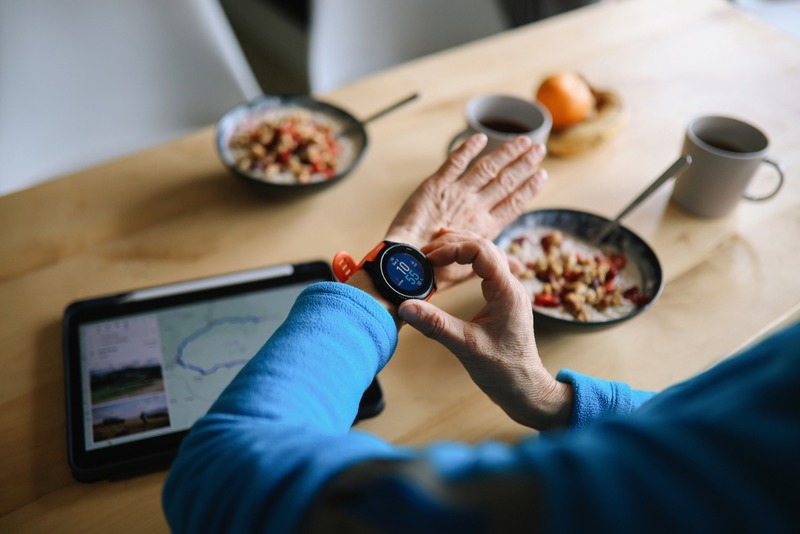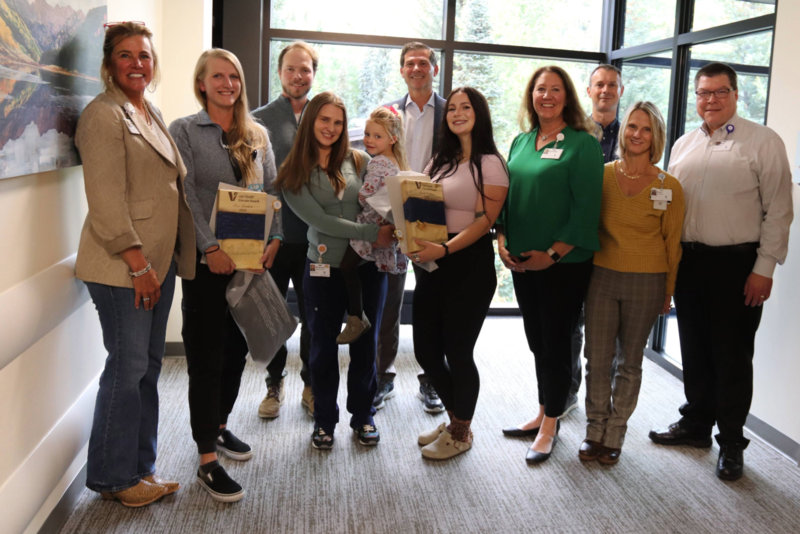News
Living on High: The Lesser-Known Effects of Living at Altitude

Living and traveling at high altitude have obvious and well-known impacts on everyone, and yet it’s becoming clear that there are lesser-known and often elusive effects on our physical and mental health. After decades of treating locals and visitors at high elevation, Vail Health and Colorado Mountain Medical’s providers continue to observe new facets of the impacts of altitude on our health.
The high altitude cocktail is deceptively simple: lower oxygen rates and higher exposure to UV rays. While air composition remains consistent no matter what altitude you’re at (79% nitrogen and 21% oxygen), the actual number of molecules decreases by volume the further you climb from sea level. That’s because atmospheric pressure pushes oxygen particles together, so the higher atmospheric pressure at sea level results in more oxygen in a given volume of air than at the lower atmospheric pressure at higher altitudes.
Mountain environments’ well-known increased UV exposure is attributed to the fact that there is less atmosphere for the rays to travel through, which also means less potential to hit radiation-absorbing chemicals than at lower elevations. Yet while these factors are easy to explain objectively, their impacts on our body function and mental processing are far more convoluted.
SKIN HEALTH
Sunburns are the big, red canary in the coal mine to remind us that ultraviolet (UV) light is more intense at elevation. In fact, while it takes 45 minutes to get a sunburn at the beach in New York in June, it only takes 12 to 15 minutes to get a sunburn while skiing in Vail in March.
All that sun exposure takes its toll. One study done in Austria in 2016 found that melanoma incidence rates amongst people living at high altitudes increased by as much as 30% per 100 meters (328 feet) of altitude. Some researchers hypothesize that the significant increase is correlated with snow surfaces, which can reflect 80% of UV rays.
Dr. Kelly Williams, a dermatologist at Colorado Mountain Medical, notes that our outdoor-centric lifestyle exacerbates the already heightened sun exposure. “I see a lot more skin cancers and skin aging here in the Vail Valley than any other place I’ve worked,” says Dr. Williams.
“You can’t treat your skin the same here as other places,” Dr. Williams advises, “and unfortunately you can’t completely reverse sun damage. But you can take steps to prevent it.” On top of reapplying sunscreen regularly and opting for long sleeves and wide-brimmed hats, Dr. Williams recommends applying a serum with Vitamins C and E in the morning to help prevent sun damage. And just in case it wasn’t already obvious, locals living at elevation should schedule an annual skin cancer screening.
EYE HEALTH
“I have seen a ton of dry eye. Most people have some degree of it at altitude,” says Dr. Morgan Godin, an ophthalmologist at Colorado Mountain Medical. “Then there’s severe dry eye—eyes looking red and irritated, that ‘foreign body’ sensation. When you first start noticing symptoms, come on in for an evaluation so we can work up a treatment plan before it gets really bad.”
Sunglasses and eye drops are the obvious preventive measures, but Dr. Williams also advises applying sunscreen above your eyes and below your eyebrows—a commonly missed spot during sunscreen application, and as a result, a common spot for basal cell carcinoma.
High elevations also make inhabitants more prone to cataracts. A study done in Nepal and reported in peer reviewed medical journals
found the prevalence of cataracts was 4.05-times greater at high altitude.
“We have to think about UV exposure because we’re closer to the sun,” says Dr. Godin. She also recommends being thoughtful when selecting eyewear, as “some sunglasses are better than others,” she says. “Look for UV protection, not just a tinted lens, but a good, dark, protective lens. Goggles in winter and wraparound-style glasses for mountain biking.”
DIGESTION & HYDRATION
Here’s where high country dwellers get a bit of a break. For the most part, the digestive system isn’t impacted much by altitude. The most common issue that gastroenterologist, Dr. Stephen Laird, sees is constipation linked to dehydration. So do your digestive system a favor and hydrate throughout the day. The general recommendation is to increase your water consumption to at least 16 cups per day in the mountains.
REPRODUCTIVE HEALTH
Many of the effects of altitude on reproductive health center around pregnant women; however, Dr. Gale Santa Maria, an obstetrician/gynecologist at Colorado Mountain Medical, has observed that many women who move to the mountains experience changes in their menstrual cycles in the first few months of living at altitude.
The specific changes vary from person to person, and research on the topic is limited. What's more widely understood is that dramatic changes in elevation can trigger pre-term labor as early as the second trimester, which is why Dr. Santa Maria suggests pregnant women considering a visit to the mountains should consult their doctor first.
While the rumor that babies are born earlier persists, Dr. Santa Maria says it's not true. They do tend to be smaller, with Eagle County babies averaging 6 to 7 pounds compared to 7 to 8 pounds nationally. The lower birth weights are likely attributed to several factors.
“We have a fitter population than other areas,” explains Dr. Santa Maria, “and women here tend to stay active throughout their pregnancies.” But it is also related to the reduced oxygen saturation. Babies at or above 6,800 feet have “normal” oxygen saturation levels between 91% to 96% compared to the 97% found at sea level. Research published in March 2020 showed that Colorado’s high altitude “reduced birth weight by 101 g and increased the risk of low birth weight by 27%.”
MENTAL HEALTH
Decades of research show the reduced cognitive function we experience with lower oxygen rates. What’s less clear is the impact of our level of altitude in the long term, once people have acclimatized.
In 2019, a study in the medical journal, Psychiatry Research, indicating a link between high altitude and higher rates of suicide, exposed a potential dark side to life in our “Happy Valley.” The study included over 9.6 million patients and showed a statistically significant progression of suicide risk per 1,000 meters. But is altitude alone to blame?
Dr. Casey Wolfington, licensed psychologist and senior director of Community Behavioral Health at Eagle Valley Behavioral Health, also points to the societal stressors of tourism-focused mountain communities. Factors like the high cost of living, job fluctuation and housing insecurity all take a heavy toll on mental health.
While research into this area is still emerging, the takeaway is clear: Caring for our mental health is imperative in mountain communities.
“People go so hard here,” says Dr. Wolfington. “We'll go to a yoga class, then ski, then do a hike in the evening. And people feel bad if they’re not performing to their best all the time.”
And while exercise is an important way to boost our mood, overdoing it can backfire. “Give yourself some grace and listen to what your body needs and mentally what you need.” Sometimes that means bowing out from another active outing and instead taking time
to connect with a friend. “You don’t necessarily have to go to an hour-long session with a therapist. A walk with a friend is just as important.” Dr. Wolfington advises tuning in to how you’re feeling, keeping in mind that your mental health is inextricably linked to your physical health and should be cared for as such.
Well, does all that have you ready to run back to sea-level? Of course not! Because mountain lovers thrive when faced with a challenge. By taking purposeful, preventive steps to protect our physical and mental health, we can make the most of the incredible life we here in the high country.
More News
-
New!
More

Counting More Than Steps: How Wearables Can Help (or Hinder) Your Health
From step counts to sleep stages, heart rate variability to blood sugar spikes, wearable devices are giving us a front-row seat to what’s happening inside our bodies. Strapped to wrists, slipped onto fingers or wrapped around our biceps, wearables like the Oura Ring or Whoop strap promise insight and advice in the quest for better health.
-
More

Cass Barham and Sarah Crabtree Honored As Recipients of Vail Health Elevate Award
Cass Barham and Sarah Crabtree, both lab techs at Vail Health Hospital, have been named recipients of the Vail Health Elevate Award. Vail Health created the Elevate Award in June 2022 to give patients and their families an opportunity to nominate and thank employees who have touched their lives in some way.
-
More

Breast Cancer Risk: Do Fruits & Veggies Matter?
Consuming a diet high in fruits and vegetables is a key habit for obtaining and maintaining a healthy weight, and there is strong evidence that obesity or being overweight increases the risk of post-menopausal breast cancer. According to the American Cancer Society, at least 18% of all cancers and about 16% of cancer deaths in the U.S. are related to excess body weight, physical inactivity, alcohol consumption, and/or poor nutrition.
